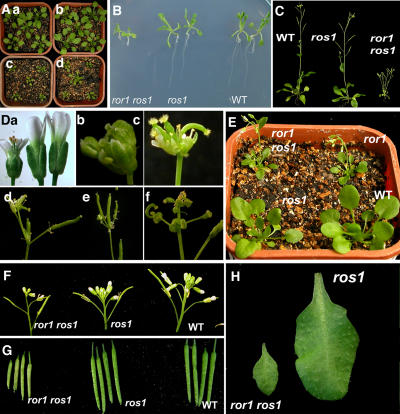Figure 5.
Growth Phenotypes of ror1 ros1 Mutants.
(A) Seedlings grown in soil for 3 weeks under long-day conditions (16 h light/8 h dark). (a) C24 wild-type; (b) ros1 mutant; (c) ror1-1 ros1 mutant; (d) ror1-2 ros1 mutant. The seedlings of ror1-1 ros1 and ror1 -2 ros1 have begun to flower.
(B) Seedlings grown on MS plates for 18 d.
(C) Seedlings grown in soil under long-day conditions for 32 d. Note that the ror1 ros1 mutant has many branches without an apparent main shoot.
(D) Comparison of flower sizes among ror1 ros1 (left), ros1 (middle), and C24 wild type (right) is shown in (a). (b) to (f) The different floral organs observed in ror1 ros1 plants. These abnormal phenotypes are seldom observed in normal ros1 or C24 plants. (b) and (c) Several siliques developing from the terminal flower. (d) Terminal floral structure in a main shoot. (e) Terminal floral structure in an axillary shoot. (f) Carpels bearing ovules.
(E) The comparison of growth phenotypes between the ror1 single mutant and ror1 ros1 double mutant.
(F) and (G) Young inflorescence structures and silique size comparison among ror1 ros1 (left), ros1 (middle), and C24 wild type (right).
(H) Mature leaf size comparison between ros1 and ror1 ros1. Note trichomes on leaf surface of ros1 but not on ror1 ros1.

